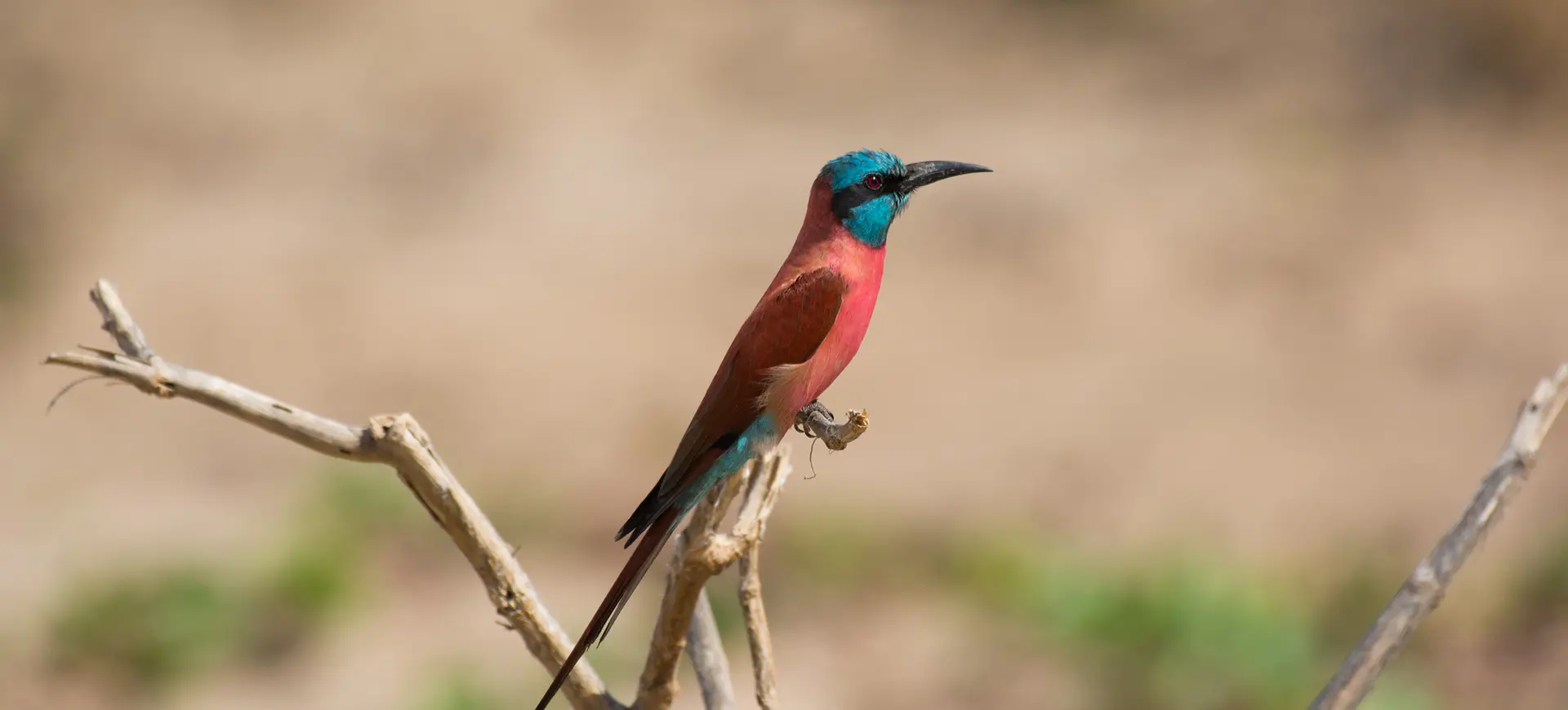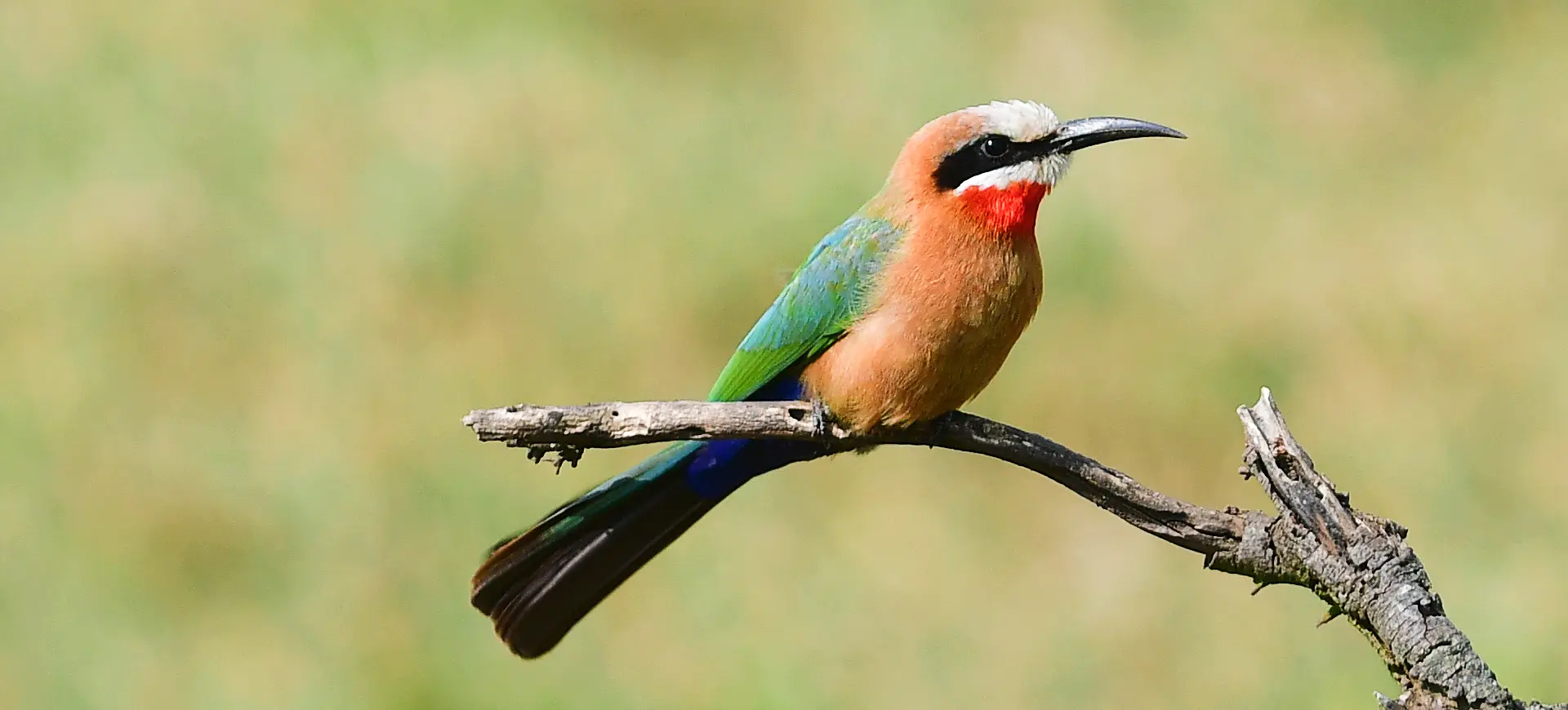Overview
The White-throated Bee-eater (Merops albicollis) is a brightly colored bird species that grace the savannas, woodlands, and forests across sub-Saharan Africa with its presence. Notable for its vivid green back, yellow throat, and distinctive white throat patch, this bird embodies the vibrant life of its native habitat. The chestnut upper breast and sharp contrast with its green abdomen further distinguish it, making it a visual highlight of the African bird world. These bee-eaters are migratory, breeding in the Sahelian woodlands before moving to the equatorial rainforests to spend the non-breeding season, demonstrating a remarkable adaptability to diverse environments.
In addition to their aesthetic appeal, White-throated Bee-eaters are renowned for their exceptional hunting abilities. They specialize in catching bees, wasps, and other flying insects mid-air. Their diet is crucial in controlling insect populations, benefiting natural ecosystems and human agricultural interests. The birds are highly sociable, often perched in large groups, and exhibit fascinating communal nesting behaviors. They excavate tunnel-like burrows in sandy banks to raise their young, showcasing intricate social structures and cooperative rearing practices within their colonies.
Conservation efforts for the White-throated Beefeater are centered on preserving the bird’s habitat, which is vital for maintaining healthy populations. These efforts highlight the species’ importance as an indicator of ecosystem health and its role in insect population control. By focusing on habitat preservation and sustainable land use, conservationists aim to ensure the White-throated beefeater thrives in its natural environment, contributing to sub-Saharan Africa’s biodiversity and ecological balance.
Taxonomy
Kingdom
Phylum
Class
Order
Family
Genus
Species
Type
Physical Description:
The White-throated Bee-eater is a medium-sized bird, measuring about 20 to 25 centimeters long, including the tail. Their body is slender and aerodynamic, an adaptation for agile flight necessary for catching insects in the air. The primary coloration is a bright green that covers the back, wings, and tail, with a distinctive white throat and chin area that gives this species its name. The eyes are surrounded by a narrow black stripe, adding to their striking appearance. The long, pointed wings and tail are adaptations for their acrobatic flying skills, crucial for their insectivorous diet.
Males and females are similar in appearance, making it difficult to distinguish between the sexes based on plumage alone. Juveniles, however, have a less vivid coloration and lack the fully developed tail streamers of the adults. The beak of the White-throated Bee-eater is long, curved, and sharp, designed for catching and handling prey. Their feet are small and weak, reflecting their lifestyle of hunting on the wing rather than foraging on the ground.

Lifespan: Wild: ~12 years || Captivity: ~18 years

Weight: Male & Female: 0.7-1 oz (20-30g)

Length: Male & Female: 7.9-9.8 in (20-25 cm)

Wingspan: Male & Female: 12-14 in (30-36 cm)

Top Speed: 18 mph (30 km/h)
Characteristic:
Native Habitat:
White-throated Bee-eaters inhabit a wide range of open landscapes across sub-Saharan Africa, from the arid edges of the Sahara to the lush greenery of the equatorial forests. They prefer open woodlands, savannas, and forest edges, particularly those with access to sandy banks or cliffs suitable for nesting. These habitats provide the conditions for their nesting colonies and offer ample opportunities for hunting their insect prey.
Their migratory pattern is closely linked to the seasonal availability of food and nesting sites. During the breeding season, they are found in the Sahelian woodlands, moving south to the equatorial rainforests during the non-breeding season. This migratory behavior underscores the need for conservation efforts across their range, ensuring the protection of critical habitats required for survival throughout the year.
Climate Zones:
Biomes:
Biogeographical Realms:
Countries:
Diet:
Diet & Feeding Habits:
White-throated Bee-eaters are specialized insectivores with a diet predominantly consisting of bees, wasps, and hornets. Their hunting technique is highly skilled; they catch their prey mid-air, returning to a perch to beat the insect against a hard surface before consuming it. This behavior helps to remove the stinger and venom from their prey, minimizing the risk of harm. Depending on availability, they are also known to consume other flying insects, including butterflies and dragonflies.
The feeding behavior of White-throated Bee-eaters highlights their importance in controlling insect populations, particularly those that can be pests to humans. They often hunt in groups, taking advantage of the increased chances of detecting and capturing prey. Their presence in agricultural areas can benefit farmers by naturally managing pest populations and showcasing the ecological value of these vibrant birds.
Mating Behavior:
Mating Description:
White-throated Bee-eaters exhibit fascinating breeding behaviors, including a strong social structure and cooperative breeding within colonies. The breeding season is marked by the excavation of nest tunnels in sandy banks or flat ground, where each pair creates a chamber at the end to lay their eggs. These colonies can consist of dozens to hundreds of individuals, highlighting the species’ communal nature. Males and females share the responsibility of incubating the eggs and feeding the chicks, with assistance from non-breeding adults in the colony, often previous offspring of the breeding pair.
This cooperative breeding system enhances the survival rates of the offspring as it increases the number of caregivers per chick. It also provides additional protection against predators and other threats to the nests. The social bonds formed within these colonies are strong, with individuals often returning to the same breeding sites year after year. This behavior underscores the importance of preserving specific nesting sites to conserve White-throated Bee-eaters.
Reproduction Season:
Birth Type:
Pregnancy Duration:
Female Name:
Male Name:
Baby Name:
Social Structure Description:
The White-throated Bee-eater is a highly social bird. It forms large colonies for breeding and is often seen perching closely together in groups. Its social structure is characterized by cooperative breeding, where individuals within a colony assist in rearing chicks, including feeding and protecting the young from predators. This cooperative behavior extends beyond the immediate family, with unrelated adults and previous offspring participating in caring for the chicks.
The formation of breeding colonies provides numerous benefits, including increased vigilance against predators, shared defense of nesting sites, and enhanced foraging efficiency. The strong social bonds within colonies are maintained through vocal communications and mutual preening, reinforcing the cohesion and cooperative nature of the group. Understanding the social behavior of White-throated Bee-eaters is essential for conservation efforts, as it influences their habitat requirements and responses to environmental changes.
Groups:
Conservation Status:
Population Trend:
The White-throated Bee-eater is classified as Least Concern by the IUCN, with a stable population trend. This status reflects the species’ wide distribution and adaptability to various habitats. However, like many bird species, it faces threats from habitat destruction, particularly from the expansion of agriculture and urban development. Additionally, the use of pesticides can reduce its food sources and pose direct risks to its health.
The White-throated Bee-eater’s conservation efforts focus on habitat preservation and sustainable land use practices that minimize impacts on the species and its environment. Protecting the nesting sites and foraging areas essential to their survival is crucial for maintaining healthy populations. Education and awareness programs can also play a role in mitigating threats from human activities, promoting coexistence, and protecting these ecologically important birds.
Population Threats:
The main threats to the White-throated Bee-eater include habitat loss due to deforestation, land conversion for agriculture, and urban expansion. These activities can destroy critical nesting and foraging habitats, impacting the species’ ability to breed and feed. The use of pesticides in agriculture poses an additional threat, reducing the availability of their insect prey and potentially causing direct harm to the birds.
Climate change also presents a long-term threat by altering the distribution and availability of their habitats and prey. Changes in rainfall patterns and temperatures can affect the timing and success of their breeding season, potentially disrupting their migratory patterns and habitat preferences. Addressing these threats requires integrated conservation strategies that consider the needs of both wildlife and human communities.
Conservation Efforts:
Conservation efforts for the White-throated Bee-eater include habitat protection and restoration, sustainable agriculture practices, and the reduction of pesticide use. Protecting key breeding and foraging habitats by establishing protected areas and wildlife reserves is crucial for the species’ survival. Community-based conservation programs involving local populations in habitat management and conservation education can also contribute to protecting White-throated Bee-eaters and their ecosystems.
Research and monitoring are important components of conservation strategies, providing data on population trends, habitat requirements, and threats’ impacts. These efforts help inform conservation actions and policies, ensuring that they effectively preserve the White-throated Bee-eater and the biodiversity of their habitats. International cooperation is also vital, as the species’ migratory nature requires conservation measures across countries and regions.
Additional Resources:
Fun Facts
- White-throated Bee-eaters have a unique method of removing the stinger from their prey before eating it.
- They are one of the few bird species known to engage in cooperative breeding, with multiple generations participating in caring for the young.
- The vibrant colors of the White-throated Bee-eater make it one of the most visually striking birds in its habitat.
- Despite their name, bee-eaters eat various flying insects, not just bees.
- Their migratory patterns are closely tied to the seasonal availability of food, showcasing their adaptability to changing environments.
- White-throated Bee-eaters are skilled flyers, capable of performing acrobatic maneuvers to catch their prey.
- The species is crucial in controlling insect populations, benefiting natural ecosystems and human agriculture.
- Their social structure and breeding behavior have been the subject of extensive study, contributing to our understanding of avian social systems.
- Conservation efforts for the White-throated Bee-eater also support preserving many other species that share their habitats.
- The calls of White-throated Bee-eaters are an integral part of the soundscape in their habitats, adding to the auditory diversity of the African savannas and woodlands.










